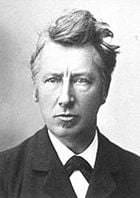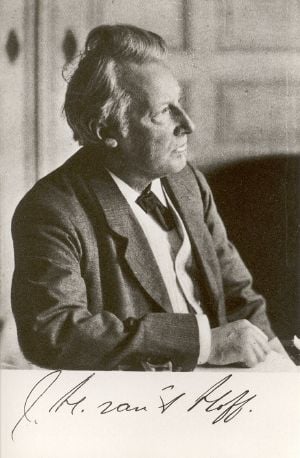Jacobus Henricus van 't Hoff
<<See the Nobel Web site. It says that van 't Hoff recognized the importance of imagination in scientific work. We need to mention that here.>>
| Jacobus Henricus van 't Hoff | |
|---|---|
| Dutch chemist | |
| Born | August 30, 1852 Rotterdam, Netherlands |
| Died | March 1, 1911 Steglitz, Berlin, Germany |
Jacobus Henricus van 't Hoff (August 30, 1852 - March 1, 1911) was a Dutch physical and organic chemist and the winner of the inaugural Nobel Prize in chemistry. His research on chemical kinetics, chemical equilibrium, osmotic pressure and crystallography is credited to be his major work. Van 't Hoff helped to found the discipline of physical chemistry as we know it today.
Early days
He was born in Rotterdam, the son of a medical doctor. From a young age he was interested in science and nature; he frequently took part in botanical excursions, and his receptiveness for philosophy and his predilection for poetry were already apparent in his early school years. (Lord Byron was his idol.)
His early education was taken in the Realschule in Rotterdam. When he was 17, against the wishes of his father, he went to study chemistry at the Delft Polytechnic Institute. He completed the three year course there in two eyars, and when he was 19, he enrolled at the University of Leiden, remaining there for a year, after which studied inBonn, Germany with Friedrich Kekulé), then in Paris with C. A. Wurtz). He returned to Holland, finally receiving his doctorate at the University of Utrecht in 1874 at age 22.
It was while he was at Utrecht that he created an upheaval in chemistry by proposing a three dimensional model for the structure of a class of carbon compounds. He shares credit for this idea with the French chemist Joseph Le Bel, who independently came up with the same idea at about the same time.
Van't Hoff later expanded this idea to account for optically active carbon compounds that affect a beam of light passing through them in a characteristic way. These discoveries opened the way for the new science of stereochemistry, which studies the three-dimensional arrangement of atoms in a chemical compound.
In 1876, Van't Hoff went to Utrecht to teach physics at the veterinary college there. In 1877, he lectured at the University of Amsterdam, and became a full professor there the following year, a post he would retain until 1896. In 1878 Van 't Hoff married Johanna Francina Mees. They had two daughters, Johanna Francina (b. 1880) and Aleida Jacoba (b. 1882), and two sons, Jacobus Hendricus (b. 1883) and Govert Jacob (b. 1889).
In 1884, van't Hoff published his research on chemical kinetics, naming it Studies in Chemical Dynamics. In this work, he shows the relationship between the concentration of compounds in a chemical reaction and the rate at which the reaction proceeds. He was also able to show how the science of thermodynamics can be applied to chemical equilibrium, where a chemical reaction that proceeds in two directions comes to a standstill. Van't Hoff also discusses the speed of a chemical reaction in its relation to temperature.
In 1885 he was appointed member of the Royal Netherlands Academy of Sciences.
In 1886, van't Hoff published a series of papers in which he showed that the same laws that apply to gases can be used to understand the behavior of solutions. This also enabled him to apply the principles of thermodynamics to solutions.
Van't Hoff's findings did not, however, apply to electrolytes—chemicals like salt that are believed to break up into electrically charged portions called ions upon entering a solution. This part of chemistry he left for Svant Arrhenius to provide the solution for a few years later.
In 1887 he and German chemist Wilhelm Ostwald founded an influential scientific magazine named Zeitschrift für physikalische Chemie ("Journal of Physical Chemistry").
Until 1895 he worked on Arrhenius's theory of the dissociation of electrolytes. On 1896 he became professor to the Prussian Academy of Science at Berlin. His studies of the salt deposits at Stassfurt contributed to Prussia's chemical industry. In these, he was able to apply results established in the laboratory to draw conclusions about the formation of salt deposits over geologic epochs.
In 1896, he was invited to take a professorship at the University of Berlin, where he was elected into the membership of the Imperial Academy of Sciences. In Berlin his teaching duties only required him to lecture once a week. The rest of his time was spent at a research facility provided by the academy. Van't Hoff was elected as a foreign member of the Royal Society of London in 1897.
In 1901 he received the first Nobel Prize in chemistry for his work with solutions.
Other distinctions included the honorary doctorates of Harvard and Yale 1901, Victoria University, Manchester 1903, Heidelberg 1908; the Davy Medal of the Royal Society 1893 (along with Le Bel), Helmholtz Medal of the Prussian Academy of Sciences 1911; he was also appointed Chevalier de la Legion d'Honneur 1894, Senator der Kaiser-Wilhelm-Gesellschaft (1911). Van't Hoff was also honorary member of the British Chemical Society in London, the Royal Academy of Sciences, in Göttingen 1892, American Chemical Society 1898, and the Académie des Sciences, in Paris 1905.
Van 't Hoff died at the age of 58, on March 1, 1911, at Steglitz near Berlin.
Stereochemistry
See also
- Van 't Hoff factor
- Van't Hoff equation
- Wilhelm Ostwald
ReferencesISBN links support NWE through referral fees
- H.A.M. Snelders, Hoff, Jacobus Henricus van 't (1852-1911), in Biografisch Woordenboek van Nederland.
- Jacobus Henricus van 't Hoff. Recognition of the extraordinary services he has rendered by the discovery of the laws of chemical dynamics and osmotic pressure in solutions. Retrieved September 18, 2005.
- Museum Boerhaave Negen Nederlandse Nobelprijswinnaars
External links
- The Nobel Prize in Chemistry 1901. Retrieved May 3, 2007.
|
1901: Jacobus Henricus van 't Hoff | 1902: Hermann Emil Fischer | 1903: Svante Arrhenius | 1904: William Ramsay | 1905: Adolf von Baeyer | 1906: Henri Moissan | 1907: Eduard Buchner | 1908: Ernest Rutherford | 1909: Wilhelm Ostwald | 1910: Otto Wallach | 1911: Marie Curie | 1912: Victor Grignard, [Paul Sabatier | 1913: Alfred Werner | 1914: Theodore William Richards | 1915: Richard Willstätter | 1918: Fritz Haber | 1920: Walther Nernst | 1921: Frederick Soddy | 1922: Francis William Aston | 1923: Fritz Pregl | 1925: Richard Adolf Zsigmondy |
Credits
New World Encyclopedia writers and editors rewrote and completed the Wikipedia article in accordance with New World Encyclopedia standards. This article abides by terms of the Creative Commons CC-by-sa 3.0 License (CC-by-sa), which may be used and disseminated with proper attribution. Credit is due under the terms of this license that can reference both the New World Encyclopedia contributors and the selfless volunteer contributors of the Wikimedia Foundation. To cite this article click here for a list of acceptable citing formats.The history of earlier contributions by wikipedians is accessible to researchers here:
The history of this article since it was imported to New World Encyclopedia:
Note: Some restrictions may apply to use of individual images which are separately licensed.


